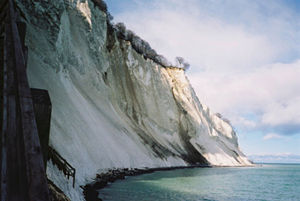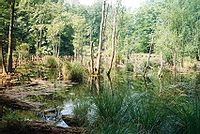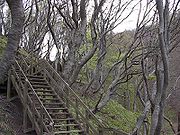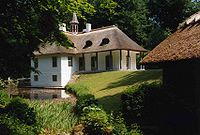
Møns Klint
Encyclopedia

Møn
-Location:Møn is located just off the south-eastern tip of Zealand from which it is separated by the waters of the Hølen strait between Kalvehave and the island of Nyord, at the northern end of Møn. Further south is Stege Bugt...
in the Baltic Sea
Baltic Sea
The Baltic Sea is a brackish mediterranean sea located in Northern Europe, from 53°N to 66°N latitude and from 20°E to 26°E longitude. It is bounded by the Scandinavian Peninsula, the mainland of Europe, and the Danish islands. It drains into the Kattegat by way of the Øresund, the Great Belt and...
. The bright chalk
Chalk
Chalk is a soft, white, porous sedimentary rock, a form of limestone composed of the mineral calcite. Calcite is calcium carbonate or CaCO3. It forms under reasonably deep marine conditions from the gradual accumulation of minute calcite plates shed from micro-organisms called coccolithophores....
cliff
Cliff
In geography and geology, a cliff is a significant vertical, or near vertical, rock exposure. Cliffs are formed as erosion landforms due to the processes of erosion and weathering that produce them. Cliffs are common on coasts, in mountainous areas, escarpments and along rivers. Cliffs are usually...
s stretch some 6 km from the park of Liselund in the north to the lighthouse in the south. Some of the cliffs fall a sheer 120 m to the sea below. The area around Møns Klint consists of woodlands, pastures, ponds and steep hills, including Aborrebjerg which, with a height of 143 m, is one of the highest points in Denmark. The cliffs and adjacent park are now protected as a nature reserve. Møns Klint is popular with tourists from across Europe with some 250,000 visitors a year. There are clearly marked paths for walkers, riders and cyclists. The path along the cliff tops provides impressive views and leads to steps down to the shore in several locations.
On 29 May 2007, close to the cliff tops, the GeoCenter Møns Klint
GeoCenter Møns Klint
GeoCenter Møns Klint is a geological museum on the island of Møn in southeastern Denmark. Located close to the top of the chalk cliffs known as Møns Klint, it was opened on 29 May 2007 by Queen Margrethe...
was opened by Queen Margrethe
Margrethe II of Denmark
Margrethe II is the Queen regnant of the Kingdom of Denmark. In 1972 she became the first female monarch of Denmark since Margaret I, ruler of the Scandinavian countries in 1375-1412 during the Kalmar Union.-Early life:...
. The geological museum with interactive computer displays and a variety of attractions for children traces the geological prehistory of Denmark and the formation of the chalk cliffs
Chalk Formation
The Chalk Group is a lithostratigraphic unit in the northwestern part of Europe. It is characterised by thick deposits of chalk, a soft porous white limestone, deposited in a marine environment during the Upper Cretaceous period.Chalk is a limestone that consists of coccolith biomicrite...
. The museum was designed by PLH Architects
PLH Architects
PLH Architects is an architectural firm based in Copenhagen, Denmark. It was founded in 1977 by Palle Leif Hansen.-Selected projects:* East Asiatic Company headquarters , Midtermolen, Copenhagen...
, the winners of an international design competition
Architectural design competition
An architectural design competition is a special type of competition in which an organization or government body that plans to build a new building asks for architects to submit a proposed design for a building. The winning design is usually chosen by an independent panel of design professionals...
.
Geology

Ice age
An ice age or, more precisely, glacial age, is a generic geological period of long-term reduction in the temperature of the Earth's surface and atmosphere, resulting in the presence or expansion of continental ice sheets, polar ice sheets and alpine glaciers...
about 11,000 years ago, the cliffs emerged. They form part of the same deposits as the cliffs of Rügen
Rügen
Rügen is Germany's largest island. Located in the Baltic Sea, it is part of the Vorpommern-Rügen district of Mecklenburg-Vorpommern.- Geography :Rügen is located off the north-eastern coast of Germany in the Baltic Sea...
, Germany, on the other side of the Baltic. Today, it is possible to find fossils of various types of shellfish as the sea continues to erode the chalk.
Erosion also caused one of the highest points on the cliffs, the "Sommerspiret", to fall into the sea in 1998, and in January 2007, there was an even larger landslide around the Store Taler, in the northern part of the cliffs, creating a 300-m long peninsula of chalk and fallen trees stretching out into the sea below.
Nature

Lady orchid
The Lady Orchid is an herbaceous plant belonging to the Genus Orchis of the family Orchidaceae.-Description: Orchis purpurea reaches on average of height. The leaves are broad and oblong-lanceolate, forming a rosette about the base of the plant and surrounding the flower spike. They are fleshy...
(Orchis purpurea) grows under the staircases leading down to the beach. The chalk also provides a distinctive light green tint to the beech trees along the top of the cliffs, maintaining their spring hues throughout the summer season. In the hilly park which stretches a couple of kilometers inland, there are a number of ponds and marshes, many populated by trees. Several signposted circuits provide opportunities for walkers, riders and cyclists to discover the surroundings.

Peregrine Falcon
The Peregrine Falcon , also known as the Peregrine, and historically as the Duck Hawk in North America, is a widespread bird of prey in the family Falconidae. A large, crow-sized falcon, it has a blue-gray back, barred white underparts, and a black head and "moustache"...
, the fastest of all birds as it swoops down to its prey at 350 km/h, has been observed breeding on Møns Klint. And the extremely rare large blue butterfly
Large blue butterfly
The Large Blue is a blue butterfly, that is resident in Europe and some parts of Asia. The butterfly was became extinct in the United Kingdom in 1979, but has since been reintroduced by conservationists...
(Maculinea arion) can also be found in the area.
Points of interest
Liselund ParkLiselund
Liselund is an 18th-century aesthetically landscaped park, complete with several exotic buildings and monuments. Located close to Møns Klint on the north-eastern corner of the Danish island of Møn, it is deemed to be one of the finest examples in Scandinavia of Romantic English gardening...
, at the northern end of the cliffs, is an attractive combination of small houses, ponds and rolling lawns built by Antoine de la Calmette for his wife Elisabeth or Lise at the end of the 18th century.

Access
Møns Klint can be reached by road either directly from StegeStege, Denmark
Stege is the largest town on the island of Møn in south-eastern Denmark. As of 2011, its population is 3,823. Stege is now part of Vordingborg Municipality and belongs to Region Zealand...
or from Klintholm Havn
Klintholm Havn
Klintholm Havn is a fishing village and a popular tourist resort on the south coast of Møn, an island in Vordingborg Municipality, southeastern Denmark. As of 1 January 2010, the population is 209.The harbour was built in 1878 by C.S...
. In the summer, there is a regular bus service. Accommodation is available within the cliff area itself or in hotels and pensions in the vicinity. There is a camping site close to the main entrance to the park and a youth hostel nearby.

